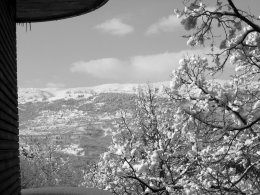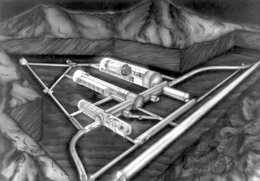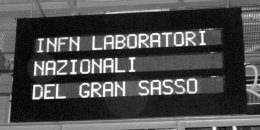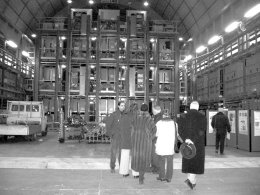 |
|
Notes from Underground
“Alcuni sono cosi ’pazzi da avventurarsi nel profondo
(“Some are so foolish as to search for the stars by Judy Jackson
In an experiment at a laboratory nestled on the flanks of the highest peaks of Italy ’s Apennines,particle physicists search for the first indications of a mysterious component of the universe known as cold dark matter.But it was the cold white matter that first struck a recent visitor to the Laboratori Nazionale di Gran Sasso last month.A late winter storm had covered the laboratory ’s mountainside campus with nearly a meter of fresh snow.Like the array of physics experiments in Gran Sasso ’s underground caverns, the effect was dazzling. More than 700 scientists from 22 countries come to carry out research at Gran Sasso,the world ’s largest underground laboratory for astroparticle physics,located in Italy ’s Abruzzo Province,some 60 miles east of Rome. They collaborate on experiments that confront the central questions of particle physics today:the nature of neutrinos,the character of dark matter, the asymmetry between matter and antimatter.What draws them here is the unique advantage provided by the Gran Sasso mountain chain itself,in the form of 1,400 meters of solid rock that shields their experiments from the constant barrage of cosmic rays that strike the earth ’s surface and interfere with the signals from neutrinos and other rare particle interactions. Plus,you don ’t need an elevator to reach the underground experiments;you can get there by expressway.A 10.4-kilometer tunnel beneath the Gran Sasso has a special members-only off ramp leading to the galleries where the laboratory ’s experimental halls are carved into the core of the mountain range.As a roadside attraction, the underground laboratory at Gran Sasso is in a class by itself.Three vast experimental halls — conveniently labeled A,B and C —along with connecting tunnels and service areas enclose an area of 180,000 cubic meters.A system of ventilation provides a constant source of fresh air,and air conditioning keeps the temperature at 18 °C.The 18-meter height of the experimental halls gives a cathedral-like aura to the space.
Indeed, said Fermilab physicist Adam Para recently, “you don ’t travel to Gran Sasso,you make a pilgrimage.It is a cathedral of astroparticle physics.” Gran Sasso is among the youngest of the world ’s particle physics laboratories;its first experiment began operating in 1989.But in the few years since,the laboratory has established itself as a world center for the exploration of neutrinos,the search for dark matter and the study of nuclear reactions in the astrophysical realm.Currently at Gran Sasso,there are eight operating experiments in astroparticle physics and three more in preparation. Neutrinos are a Gran Sasso specialty.Experiments now in progress or under construction can zoom in on the behavior of solar neutrinos,atmospheric neutrinos,neutrinos from supernovae and now, after the completion of the new neutrino beamline at CERN,some 730 kilometers away,neutrinos produced at a particle accelerator.Results from Gran Sasso experiments have contributed significantly to the dawning recognition that neutrinos do,in fact,possess mass,however small.And Gran Sasso is the undisputed world leader in the use of so-called “double-beta-decay ” experiments to investigate whether neutrinos are their own antiparticles. When the ICARUS and OPERA experiments begin operating in about 2006,they will provide the opportunity for experimental physicists to observe the phenomenon of neutrino oscillations by “appearance ”experiments.Hitherto,experimenters have successfully detected the presence of neutrino oscillation mainly by observing a deficit in the expected number of neutrinos of a particular flavor.The missing neutrinos have “disappeared ” by oscillating into neutrinos of a different flavor. ICARUS and OPERA,however,will actually be able to detect the appearance of tau-flavored neutrinos in a beam of pure muon neutrinos generated by a particle accelerator at CERN, confirming and complementing the results of atmospheric neutrino studies in the Super- kamiokande experiment,and other long-baseline neutrino experiments such as KEK ’s K2K experiment in Japan and Fermilab ’s MINOS in northern Minnesota.
Besides neutrinos,other astroparticle experiments study nuclear reactions in the sun,the nature of the dark matter that makes up more than 20 percent of the universe,and even the effect of particles on biology.A Gran Sasso experiment looks at the rate of genetic modification in an environment sheltered from the effects of cosmic rays.Early results seem to indicate that without interaction with particles from space,the organisms ’genetic make-up does not change. Gran Sasso ’s environment feels a long way from the western suburbs of Chicago.The style of the above-ground facility,a twenty-minute trip from the underground laboratory,falls somewhere between a college campus and a ski resort.Located within the Parco Nazionale del Gran Sasso,it perches in the mountains between the medieval cities of l ’Aquila and Teramo in the heart of the Abruzzo province.For centuries,its impervious territory isolated the Abruzzo from the rest of Italy and Europe.In the 1960 ’s,the construction of highways from Rome,Bologna and Bari opened the region to the outside world,but it retains the distinctive atmosphere of a region apart.Like laboratories in the U.S.,however,Gran Sasso must also address concerns of citizens in neighboring communities, and laboratory officials give high priority to environmental issues.
Results from astrophysics and particle physics experiments over the past five years have revolutionized our understanding of the nature of the universe.The ordinary hadronic matter that not long ago seemed dominant is now revealed to constitute a paltry few percent of the actual mass of the universe.The rest belongs to dark matter and dark energy,whatever they may turn out to be. “Don ’t let the bright lights fool you,”says astro- physicist Michael Turner of Fermilab and the University of Chicago.“The Dark Side controls the universe.” In the years ahead,some of the brightest light on the dark universe may shine from underground, from experiments deep in the rocky heart of the Gran Sasso.
ON THE WEB: Gran Sasso: http://www.lngs.infn.it
|



